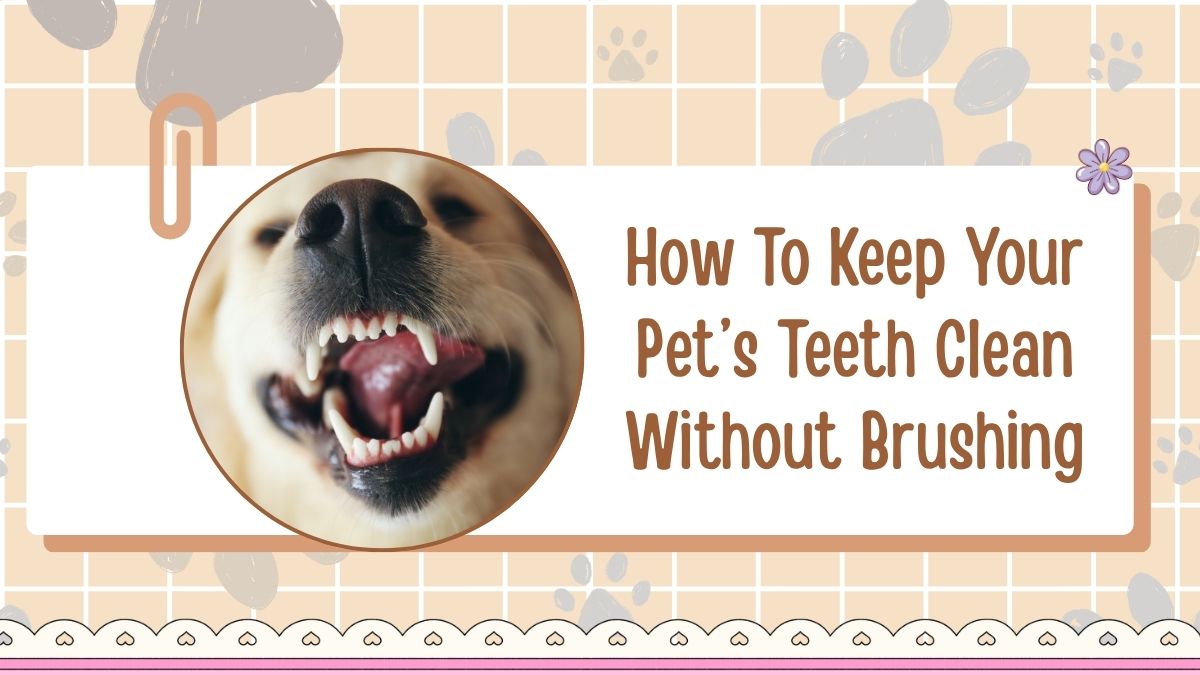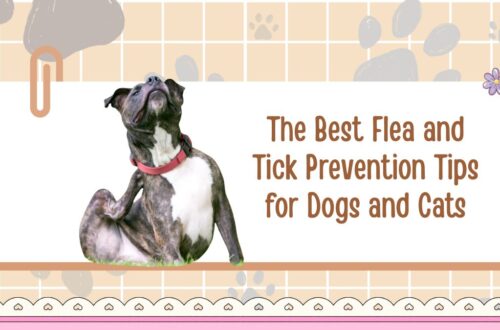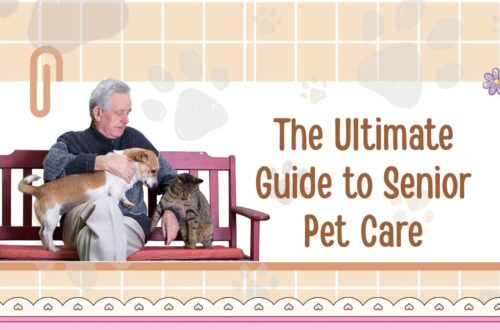Keeping your pet’s teeth clean is essential for their overall health, but let’s face it — not every dog or cat will sit still for brushing. The good news? You can still maintain your pet’s dental hygiene without ever picking up a toothbrush.
This guide covers effective, veterinarian-approved methods, complete with facts, practical steps, and a helpful comparison table to make oral care easy, safe, and stress-free.
Why Dental Health Is Crucial for Pets
Dental disease is one of the most common health issues in pets. Studies show that by age three, 80% of dogs and 70% of cats show signs of periodontal disease. Poor oral hygiene can lead to:
- Pain and tooth loss
- Bad breath and drooling
- Difficulty eating or chewing
- Heart, kidney, or liver issues from bacteria entering the bloodstream
So even if brushing isn’t possible, taking preventive steps will save your pet from discomfort — and save you costly vet bills later.
What Happens If You Don’t Brush
Skipping dental care leads to a buildup of plaque, which hardens into tartar within 48 hours. This attracts harmful bacteria that cause inflammation, gum recession, and bone loss.
Once tartar builds under the gumline, it becomes nearly impossible to remove without a professional cleaning.
That’s why adopting non-brushing dental routines early can make a major difference.
Effective Alternatives to Brushing
Let’s explore proven methods that keep your pet’s mouth clean and breath fresh — no toothbrush required!
1. Dental Chews and Treats
How They Work:
Dental chews are designed to scrape plaque and tartar off your pet’s teeth as they chew. Many contain enzymes or natural ingredients that fight bacteria and freshen breath.
Benefits:
- Easy and enjoyable for pets
- Helps remove surface plaque
- Reduces bad breath
- Encourages healthy chewing habits
Tips for Use:
- Offer 1 dental chew daily after meals
- Choose size-appropriate treats for your pet’s breed and age
- Avoid high-calorie treats if your pet is on a diet
2. Chew Toys and Bones
How They Work:
Safe chew toys and raw bones provide mechanical cleaning by rubbing and scraping tooth surfaces, preventing plaque accumulation.
Benefits:
- Keeps teeth polished naturally
- Strengthens jaw muscles
- Relieves stress and boredom
Tips for Use:
- Always supervise chewing sessions
- Avoid cooked bones (they can splinter)
- Pick durable rubber or nylon toys with ridges or nubs for better cleaning
3. Dental-Friendly Diets and Hard Kibble
How They Work:
Specially formulated dental diets and textured dry kibble create a gentle scrubbing action as your pet chews.
Benefits:
- Helps remove soft plaque
- Maintains gum health
- Simple to integrate into daily feeding
Tips:
- Feed a mix of wet and dry food for balance
- Use kibble designed for dental health (larger pieces promote chewing)
- Ensure your pet drinks plenty of water to wash away food particles
4. Water Additives and Oral Sprays
How They Work:
These are liquid solutions or sprays added to your pet’s water bowl. They contain enzymes, chlorhexidine, or zinc compounds that neutralize bacteria and prevent plaque formation.
Benefits:
- Effortless and stress-free
- Keeps breath fresh all day
- Prevents bacteria buildup between meals
Tips:
- Use daily for consistent results
- Replace water every 24 hours
- Make sure your pet tolerates the flavor before regular use
5. Dental Wipes and Gels
How They Work:
Dental wipes or gels can be applied to your pet’s teeth and gums to remove plaque manually or inhibit bacterial growth.
Benefits:
- Great for pets that dislike toothbrushes
- Gentle and easy to use
- Removes surface buildup
Tips:
- Rub gently along the gumline once a day
- Start slowly to help your pet get used to the sensation
- Store wipes in a cool, dry place for freshness
6. Professional Dental Cleaning
How It Works:
A professional vet cleaning under anesthesia removes hardened tartar, checks for gum disease, and polishes the teeth.
Benefits:
- Deep cleaning below the gumline
- Prevents serious dental disease
- Detects oral health issues early
Tips:
- Schedule annually or as recommended by your vet
- Maintain with chews and rinses between visits
- Avoid unlicensed or “non-anesthetic” cleanings, as they may not remove plaque under gums
Pet Dental Care Without Brushing
| Method | Action Type | Main Benefit | Drawback | Best For |
|---|---|---|---|---|
| Dental Chews | Mechanical / Enzymatic | Reduces plaque, freshens breath | May not reach gums | Daily easy maintenance |
| Chew Toys / Bones | Mechanical | Scrapes tartar, relieves stress | Risk of breakage if unsupervised | Active chewers |
| Dental Diet / Kibble | Mechanical | Removes food debris, gentle cleaning | Limited gum reach | Pets that prefer food-based care |
| Water Additives | Chemical | Kills bacteria, prevents new plaque | Some pets dislike flavor | Pets that hate oral handling |
| Wipes / Gels | Manual / Chemical | Removes surface plaque | Needs cooperation | Sensitive pets or senior animals |
| Vet Cleaning | Professional | Deep cleaning below gumline | Requires anesthesia, cost involved | All pets yearly or as needed |
The Perfect Daily Routine (No Brushing Needed)
Here’s a simple 7-day schedule to keep your pet’s mouth clean and odor-free:
Daily Routine
- Give a dental chew or textured toy after meals.
- Add oral rinse or water additive in their bowl.
- Provide crunchy kibble for one meal.
- Inspect their mouth for redness or buildup.
Weekly Tasks
- Use dental wipes twice a week to remove soft plaque.
- Sanitize chew toys and replace worn-out ones.
- Reward your pet with praise after every session.
Monthly Tasks
- Assess gum color (should be pink, not red).
- Book a dental check if you notice swelling, bleeding, or foul odor.
Understanding Breed and Age Differences
- Small dog breeds like Chihuahuas and Yorkies have crowded teeth, increasing tartar buildup — give smaller, softer chews.
- Flat-faced breeds (Pugs, Bulldogs) need extra care since saliva doesn’t flow well in compact mouths.
- Cats benefit from dental gels and dry kibble more than chews.
- Senior pets may have weaker teeth — switch to soft dental treats or gels for gentle cleaning.
- Puppies can start early with rubber teething toys to encourage healthy habits.
Common Dental Care Mistakes to Avoid
Even with the best intentions, pet owners often make these mistakes:
- Using human toothpaste: Many contain fluoride or xylitol — both toxic to pets.
- Feeding only soft food: It sticks to teeth and accelerates decay.
- Skipping regular vet visits: Early dental disease is often invisible.
- Overusing bones: Hard items can crack teeth or cause blockages.
- Ignoring bad breath: It’s often the first sign of gum disease.
Avoiding these pitfalls ensures your efforts pay off — and your pet stays comfortable and healthy.
Fun Facts About Pet Dental Health
- Dogs have 42 teeth, while cats have 30 — each type of tooth serves a specific purpose.
- A healthy pet mouth has pink gums and minimal odor.
- Chewing can reduce plaque formation by up to 70% when done regularly.
- Small breeds are five times more likely to develop dental problems than large breeds.
- Dental health directly affects lifespan — pets with clean teeth live up to two years longer on average.
Signs Your Pet Needs Dental Attention
Watch out for these red flags that indicate dental issues:
- Persistent bad breath
- Drooling or pawing at the mouth
- Red or bleeding gums
- Loose or missing teeth
- Difficulty eating or sudden food refusal
- Swelling around the mouth or jaw
If you notice these symptoms, schedule a veterinary dental exam immediately. Early treatment prevents pain and further complications.
Expert Tips for Success
- Start slow and reward your pet after every cleaning activity.
- Pair dental chews with daily playtime to make it fun.
- Offer cold carrots or frozen treats to soothe teething puppies.
- Rotate different cleaning methods (chews, rinses, wipes) for variety.
- Stay consistent — it’s daily routine, not intensity, that protects teeth.
Cost-Saving Insight
Investing in preventive dental care can save you hundreds of dollars annually.
Professional dental cleanings can cost between $300 and $1,200, depending on severity. By maintaining oral health at home using non-brushing methods, you minimize the need for frequent deep cleanings — saving money and keeping your pet stress-free.
Final Word: Clean Teeth, Happy Pet!
Brushing your pet’s teeth may be ideal, but it’s not the only way to protect their smile. Using dental chews, toys, water additives, and periodic vet cleanings can keep your furry friend’s teeth strong and their breath fresh — no brushing required.
Consistency and patience are key. Start small, keep it fun, and you’ll notice improvements within weeks.
Because a healthy mouth means a healthier, happier pet — and that’s something to smile about!
FAQs
You can use dental chews, water additives, and chew toys made from natural rubber. Adding crunchy kibble and fresh carrots can also help remove plaque naturally.
Use oral gels or wipes that don’t require chewing. Cats often tolerate soft, meat-flavored gels better than hard chews.
Most pets benefit from annual dental exams. However, if you notice bad breath, bleeding gums, or drooling, book an appointment immediately.





